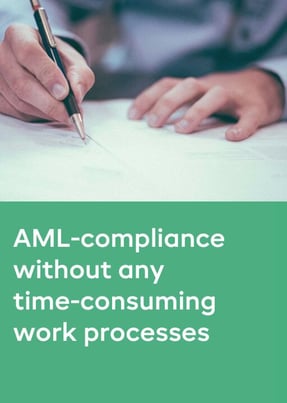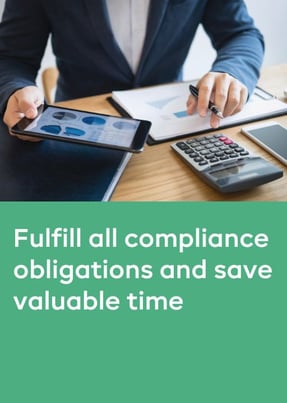- Products
- RegLab for ...
- Knowledge centre
Download the AML glossary >
 Discover the essential AML compliance terminology and gain instant access to a comprehensive guide
Discover the essential AML compliance terminology and gain instant access to a comprehensive guide - The company
Working at RegLab >
There may not be any vacancies that perfectly match your profile, but that does not mean there is no room for someone who can improve RegLab.
- Book a demo
How did you design the compliance officer position?
Question no. 6 from the supervisor
The compliance officer position has been introduced in the legal profession in recent years. This is mainly because the AML requires that large firms appoint a compliance officer. The AML risk level of an office also plays a role when it comes to whether or not a compliance officer role should be given shape.
When do you need a compliance officer?
AML legislation obliges law firms with more than 50 lawyers to appoint a compliance officer. This officer must be able to operate independently of the board. What about smaller offices? When appointing a compliance officer, be it mandatorily or not, a law firm should not only look at its size, but also at the nature of its services. For example, if a smaller office handles a relatively large number of high-risk clients, that office must also appoint a compliance officer. You can find out in previous articles of this series how you should determine whether your matters or files are subject to the AML. Screening and accepting clients is one thing, indicating the right interpretation is another. We explain how to proceed, in accordance with the supervisor's wishes and requirements, based on the four aspects below.
- Bear in mind the role and the tasks
It is crucial that careful thought is given to the compliance officer position. Think out this role and prepare the work process. Keep in mind these two questions:
- How far does this officer go in advising and what does he or she report?
- When do employees of your office forward a file to the compliance officer and what are the next steps?
These are all questions that you need to answer. If you are new to this position, talk to fellow firms that already have a compliance officer or call in a specialist. RegLab cannot only help to shape the role, but also possibly take care of its implementation. You can read more about the RegLab’s AML support here.
- Include the position in your risk policy
As soon as the position and the exact role within the AML work process have been determined, it is important to include this position and the name of the compliance officer in the risk policy. If you have not got one yet, then read this article for tips and a free checklist for drafting a risk policy.
- Make sure the compliance officer is taken seriously
Appointing a compliance officer does not mean implementing the AML risk policy. The entire office is needed for that. Ensure that this officer receives backup and a mandate from management. People often think: “The compliance officer is simply going to check some files.” Wrong. Compliance officers must be able and allowed to be critical and be given the space to make employees aware of the AML and the work process.
- Provide the compliance officer with the right tools
Make sure that a compliance officer has access to the right tools. If he or she has to perform all activities manually and no data is available for reports, it is difficult to take steps. Invest in supporting tools, so that the compliance officer can do his job more efficiently and can focus on data (rather than individual files).
Florent's Experience
We asked Klaske Glebbeek, knowledge manager at the law firm Florent, about her experience in filling the position of compliance officer.
“Meeting AML requirements revolves around various aspects. First of all, you need a policy, but that policy must also be implemented. AML Software facilitates our lawyers to follow up the AML process. Ultimately, however, it is the lawyers themselves who must weigh up the risk profile. On the one hand, this requires awareness in the form of training, but also in the form of continuous monitoring and adjustment. This is exactly where the compliance officer helps us – in our case an external compliance officer from RegLab.”
The compliance officer checks files and discusses any ambiguities and gaps with the employees involved at Florent. He is also the person to go to if files turn out to involve an increased risk. Klaske comments with a satisfied smile: “We recently had an audit from the Dutch Bar Association (NOvA), which also included the AML, and we passed with flying colors, partly thanks to the software and the compliance officer.”
Benefits of having a compliance officer
For many firms, hiring a compliance officer feels like an obligation. Well, that is the case from a legal point of view. Nevertheless, we would like to ask you to see this role as a way to expand your office. The more so with a view to responsible business. A good compliance officer influences the behaviour of the entire office in a positive way. Therefore, we would like to conclude this article with the benefits of hiring a compliance officer.
- Professional demeanour towards supervisors, third parties and clients.
- Greater control over the AML process and can monitor progress.
- Improved adherence to the dual control principle.
- Compliance with all insurance requirements.
- Reduced administrative burden on the lawyer.
- Always up to date AML processes and risk policy and in accordance with the latest legislation.
- Provision of training and knowledge sharing - now a common public good.
Themed file: fully prepared for the supervisor’s audit
This article is part of a number of articles and downloads that will help you prepare yourself for the supervisor’s visit. This content is based on a supervisor's FAQs during an audit. Do you want to be 100% AML-proof and ready for the supervisor’s visit? Find all FAQs in our Knowledge Centre.





